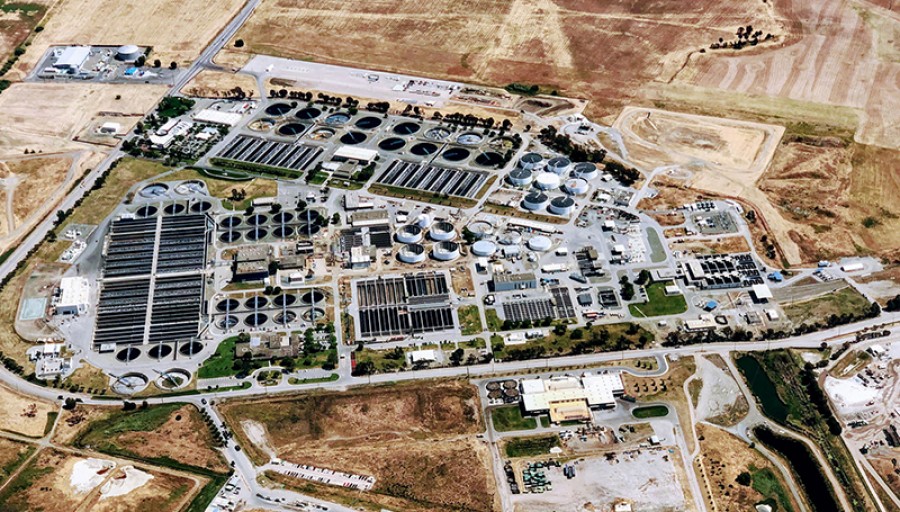FRP Composites, the Sustainable Material for Water & Wastewater Treatment Applications

Fiber-reinforced polymer (FRP) composites, specifically glass fiber-reinforced polymer (GFRP) composites, have become a popular choice for replacing aluminum, stainless steel, and steel in water and wastewater applications.
Water and wastewater treatment facilities are prone to corrosion risk, resulting in loss of structural integrity and deterioration. Continuous exposure to saltwater (in desalination plants), chemicals, and extreme temperatures all contribute to the shortened lifespan of structures and components. It is a never-ending challenge for operations and maintenance (O&M) engineers to ensure productivity and reduce disruptive maintenance.
Using a corrosion-resistant material, like GFRP composites, is just one way to increase resilience, improve life cycle outcomes, and reduce maintenance expenses.
Urgent need for GFRP composite solutions
Steel, stainless steel, and aluminum are the common materials used in water and wastewater structures for decades. There are two key issues that are driving the urgent need to investigate alternate materials.
- Existing facilities in the US are aging and must handle a larger portion of the nation’s water and wastewater demand as the population grows. Many of these plants are operating at less than their design capacities resulting in extra maintenance costs to manage the facilities. Upgrading and repairing old infrastructure in a climate of spending gaps and budget shortfalls only serves to worsen the problem.
- Exposure to effluent, sulphates, and gases can accelerate corrosion risk that leads to early equipment failure and structural damage if not maintained.
Wastewater operations are typically the largest energy expense in a community, and reductions in energy usage can yield significant environmental, economic, and social benefits for these communities. Source: US Office of Energy Efficiency & Renewable Energy
Funds spent on plant operation and maintenance of water utilities have risen over time as systems have expanded, while real spending (and even nominal spending) on capital infrastructure has been on the decline. Almost all of the spending on operations and maintenance comes from state and local governments, with the federal contribution generally running less than one percent.
Source: the aging water infrastructure: Out of sight, out of mind?
The challenges faced in the US are prevalent worldwide. The urgency to improve lifetime cost savings and improve performance is driving interest in GFRP (glass fiber-reinforced polymer) composites as a replacement material to deliver value, resilience, and durability.
Why is glass fiber-reinforced polymer components replacing steel, aluminum and stainless steel?
There are many advantages to using GFRP composites in place of traditional materials. Here are the significant ones:
Corrosion-free: GFRP composites will never corrode, rust, or cause concrete spalling in concrete structures – a critical consideration for composites vs. steel, aluminum, and stainless steel.
- Aluminum is more cost-effective than stainless steel, more corrosion-resistant than mild steel, and significantly cheaper than stainless steel, but it is prone to galvanic corrosion.
- Aluminum is anodized for protection in water applications, but it is a less than perfect solution as the anodization can scratch off. A small scratch will start the corrosion process, reducing the lifespan.
- Stainless steel is also considered corrosion-resistant, but in submerged environments, stainless steel is still subject to corrosion.
Highly chemical resistant: Wastewater treatment, water care, and desalination plants are exposed to chemicals, water, or high salt content. Composites are also favored by the oil, energy, and mining industries – environments that are subjected to highly corrosive chemicals.
Substantial life-cycle cost savings: GFRP composites are highly durable. As a result, life-cycle cost savings are achieved by significantly reducing spending on upgrades and maintenance.
High Flexural Modulus: The flexural modulus of pultruded composites is higher than that of thermo-plastics – an ideal trait for critical components used for aerating wastewater. The ability to cope with the high flexural load demands with relatively low flex is useful for any movement in the water.
Dimension stability: The dimensional stability of the pultrusion manufacturing process is consistent and can deliver tight tolerances when used as part of a complete system.
Low moisture absorption: Unlike many plastics, moisture absorption of pultruded GFRP composites is extremely low, so there is no size change or loss of mechanical properties when submerged for long periods of time.
Fit-for-purpose finishing: Surface veils, UV coating, drilling, shaping, painting, and customized add-ons are all possible. At Pultron, we run over 50 different finishing technologies to suit the application.
Adaptability: GFRP composites will perform in wastewater, stormwater, and water treatment facilities. They are easily adaptable for use across all water infrastructure.
Pultrusion components can be designed fit-for-purpose
Pultron has developed several critical fiberglass components used in the wastewater industry:
- Fiberglass rods with machined details for large water filtration systems used in water treatment plants.
- Blades fitted with a perforated silicon rubber membrane for aeration to help with sewage breakdown.
- Mateenbar™ concrete reinforcement provides a corrosion-resistant solution in concrete structures that are under attack from aggressive ions that result in concrete spalling in harsh environments.
The good news is that the water and wastewater treatment sector is addressing these challenges by looking at custom GFRP composite materials as a sustainable choice to achieve longer life cycles, and greatly reduce the need for maintenance.
Read our earlier post, Composites Explained: The Four Reinforcement Fibers to learn more about composites.
Have questions about composites and pultrusion? Talk to one of our experts.